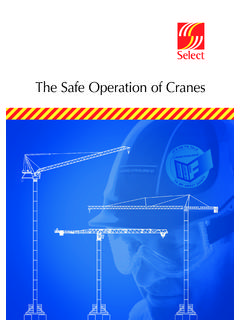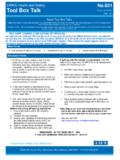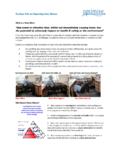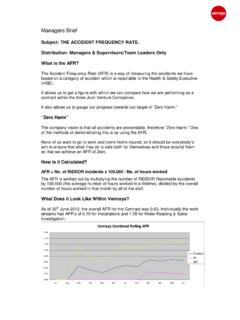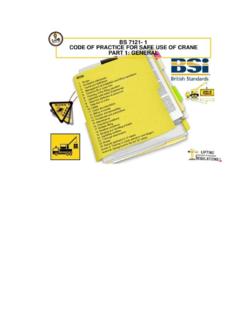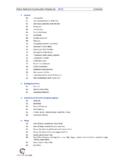Transcription of Guide to Safe Slinging and Signalling
1 Guide to safe Slinging and Signalling23 Personal MessageContentsIntroductionLaing O Rourke holds Health and Safety as a core business value and is committed to achieving our vision; Let s all get home safely. Every day .Our aspiration is that we will strive to create a health and safety culture where:Clients choose to work with us because of our relentless commitment to health and safety All our sites have a consistent look and feel and are of the highest possible health and safety standard Our stakeholders feel proud, empowered and recognised for their contribution to health and safety We feel happy for family and friends to work with us or visit our sites to see how we mitigate risk to ensure no one gets hurt and we all get home safely every day We are recognised as having a world class approach to health and safety.
2 Ray O RourkeIntroduction 2 Who Does What? 6 Planning the Lift 8 Types of Equipment 11 Choice of Sling 14 safe Use of Slings 15 Schedule of Common Lifts 22 Common Loads 23 The Lift 28 Positioning of Mobile Cranes 31 Outrigger, Crawler and Axle Loads 31 Lifting with Excavators 32 Lorry Loaders 32 Lifting with Forklifts and Telescopic Handlers 33 Care of Lifting Accessories 34 Signalling 35 Load vs Sling Angles 38 Angle Guides 3945 IntroductionIntroductionThe procedures and methods outlined in this booklet are mandatory on all Laing O Rourke sites and must be followed by all Laing O Rourke businesses and their subcontractors. Additional procedures may apply when working with different Principal Contractors. Their authorisation must be recorded by the appointed person responsible for lifting on the site.
3 Slingers/signallers must know who their crane supervisor is, and supervisors must ensure that slinger/signallers are working to agreed appointed person must ensure that everyone in the crane team has studied this booklet. The purpose of the booklet is to give guidance on the correct, efficient and safe way to lift, move and place everyday items on construction sites. Where the circumstances of the lift are not covered by this booklet, additional procedures must be developed by the appointed person (lifting) and the crane team must be properly briefed in those simplicity, this booklet will refer to all lifting equipment as cranes, but this will cover all lifting equipment where the load is suspended including: Tower cranes Mobile and crawler cranes Lorry loaders Runway beam hoists Fork lift trucks fitted with a hook Excavators fitted with a lifting hook/eye Scaffold cranes.
4 The Laing O Rourke A4 booklet The safe Operation of Cranes (below) contains the arrangements for the overall management of lifting arrangements are mandatory for all Laing O Rourke crane operations and a copy of the booklet is held by the appointed safe Operation of CranesOnly authorised persons holding a valid CPCS slinger / signaller card are allowed to attach or detach slings and give signals to the crane operator. 67 Who Does What?Who Does What?Crane Co-ordinator The Crane Co-ordinator will plan the sequence of operations of cranes where there is more than one crane to ensure components and cranes will not Driver/Operator (CPCS Card)This is the person who will operate the crane to position loads or to rig the crane. Slinger/Signaller (CPCS Card)The person responsible for: Attaching and detaching the load to and from the crane The use of correct lifting accessories Initiating and directing the safe movement of the crane and Person (CPCS Card)The competent person appointed to have overall control of all lifting operations on responsibilities will include: The overall planning of lifting operations The production of method statements The completion of the Lifting Operations Assessment Form Authorisation of slingers/signallers Maintaining records of tests and inspections of lifting accessories and equipment.
5 Crane Supervisor (CPCS Card)The crane supervisor will direct and supervise lifting operations on a day to day basis to ensure compliance with the agreed and planned methods and correct practice. 89 Planning the Lift Planning the Lift Planning all LiftsLifting operations must be planned to ensure that lifts are carried out safely and efficiently. The following points must always be considered: Where loads are to be picked up Where loads are to be placed What areas are to be passed over Proximity of the public Any obstructions in the way How the load is to be slung How slings are to be removed and access to them How the crane driver will be directed The weight of the load The radius of the lift Any loads from a crane or outriggers and the capacity of the ground or slab to support themWeather conditions and light.
6 For all cranes the Laing O Rourke Lifting Operations Assessment Form (LOAF) must be completed. The Project Health and Safety Plan will record the overall project specific arrangements for the control of lifting operations. The Project Lifting Plan will detail the specific arrangements for Schedule of Common Lifts will define and describe the common lifts on the project. Depending on the nature and complexity of the lift these could be categorised as:Basic Standard Complex. Basic lifts involve:Loads of established weight where there are no hazards or obstructions within the area of operation. Typical examples are pallets of bricks or blocks, bundles of rebar, scaffold lifts involve:The lifting of general, frequently handled items of established weight, with no special lifting accessories being required.
7 This booklet describes the Slinging of this type of load and the methods shown are to be used, unless stated otherwise by the appointed lifts may include:Large pre-cast units, plant such as air handling units, generators etc. Complex lifts may require: Special lifting accessories such as spreader beams to ensure that the load is lifted safely and without damage Special connectors to connect to special built in lifting points. Complex lifts may also involve: Turning loads over or standing them upright Using more than one crane to lift a load (tandem lifts). Therefore, complex lift operations will require:Consultation with the manufacturer, supplier or designer regarding the correct way of Slinging complex loads Careful planning The production of a specific method statement.
8 Note: Where businesses within Laing O Rourke ( Expanded, Select, Malling) are contractors working for Principal Contractors other than Laing O Rourke, other procedures may apply. These will identify which lifting operations will require specific method statements. 1011 AlwaysEnsure that only authorised slingers / signallers attach or detach loads or signal the crane operations with the crane operator. Ensure capacity of crane is sufficient to land load before the weight of the slings etc in the load on the lifting expert advice when using eyebolts, plate clamps, bull dog grips, chain blocks confirmation that pre-fabricated rebar assemblies such as pad foundations and beams have been fabricated to allow safe that scaffold towers you are asked to move are designed to be lifted hand/tag lines around hand or tie wires or banding to lift a suspended load loads over the public.
9 Use lifting accessories for towing or or climb on machines or suspended near power lines. Stand or walk beneath a two or more independently slung loads at different levels on the same lift (sometimes known as chandelier lifts).Planning the Lift Types of EquipmentChain SlingsChains are generally the most versatile type of sling, as well as being the most robust. General purpose slings usually have one, two, three or four that the allowable load is reduced when not using all legs. For further information refer to pages 16 to clutchesShortening clutches enable a multi legged chain sling to have different length legs to adjust to the balance or required lifting angle of the load. Clutches must be correctly fitted to avoid failure or shortening of the chain SlingShortening Clutch1213 Types of EquipmentWire Rope SlingsWire rope slings are normally used for specific items as they are cheaper than chain slings and can be made to exact lengths for loads requiring odd leg lengths.
10 They cannot be bent round sharp corners however and should be used primarily where shackles are used to attach the sling to the Rope SlingWebbing SlingRound SlingRound and Webbing SlingsRound slings and Webbing slings are used for easily damaged loads, and for their lightness and ease of handling when long lengths are required. However, they are susceptible to damage and must be protected from sharp edges and from sliding along the load if used at an angle. Refer to manufacturers literature for colour coding and further information. Slings must be visually checked before use and immediately removed and put beyond use if of EquipmentEnd FittingsThe end fittings on chain slings (and occasionally rope slings) will generally be either sling hooks fitted with safety catches or C hooks.

